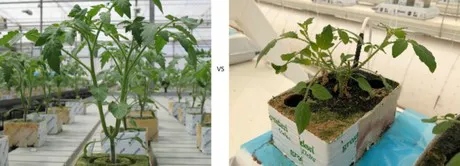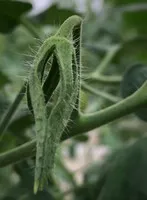Managing humidity provides the biggest challenge in learning how to work with a semi-closed glasshouse. So much so that Godfrey Dol, an expert on growing in semi-closed glasshouses, wants to spend some time discussing it.
But before he gets into the technicalities of what humidity means in a semi-closed glasshouse, he first wants to understand something that is very basic, yet not always properly understood or accepted.
Low humidity is a vegetative action
While at first, it would seem that low humidity acts as a generative impulse on a plant (creating stress is a generative action), prolonged exposure to low humidity has the reverse effect. The following example about a tomato plants’ early life in a conventional glasshouse, will explain this seemingly contradictory statement.
In the Netherlands, most tomato plants are propagated and planted around November. The plants are large (Figure 1a) and starting to flower. When planting occurs, the glasshouse vents are closed due to cold outside conditions. This means that moisture only disappears through condensation against the glass and through leakage.
The only air movement in the glasshouse is a consequence of HAF fans and convection. As the plants grow bigger, they create more moisture inside the glasshouse. After a while, the grower needs to open the vents in order to remove humidity. However, most of the plants' early life is spent under low light and high humidity conditions.
 Figure 1a and 1b: Countries with an emerging glasshouse industry plant smaller plants compared to countries with an established glasshouse industry.
Figure 1a and 1b: Countries with an emerging glasshouse industry plant smaller plants compared to countries with an established glasshouse industry.
Now compare this to a much warmer climate, for instance, Sydney, Australia. In winter, the maximum day temperature nudges 20 degrees Celsius and the light intensity approaches 700 watts/cm2. Typical of countries with an emerging glasshouse industry, there is a lack of propagators, so most growers are forced to plant a very small plant such as shown in figure 1b.
The combination of warm weather, high radiation and the low cooling capacity of small plants, forces the vents open in order to maintain a temperature of less than 30 degrees Celsius. Under these conditions, the humidity drops to very low levels (less than 20%). With vents wide  open, the air exchange also increases, exposing the plants to lots of air movement. The plants respond to this environment by making large leaves. The copious amounts of sunlight provide the plants with the ability to make plenty of assimilates, but the priority for the plant is to cool itself. As a result, the plant makes beautiful large thick leaves making the plant so vegetative that fruit setting is negatively impacted. Often the green parts of the calyx are so strong that it stops the flower from opening. (see figure 2).
open, the air exchange also increases, exposing the plants to lots of air movement. The plants respond to this environment by making large leaves. The copious amounts of sunlight provide the plants with the ability to make plenty of assimilates, but the priority for the plant is to cool itself. As a result, the plant makes beautiful large thick leaves making the plant so vegetative that fruit setting is negatively impacted. Often the green parts of the calyx are so strong that it stops the flower from opening. (see figure 2).
Figure 2, Calyx sticking as a result of vegetative growth resulting in poor setting.
Poor pollination leads to an unbalanced plant and it becomes even more vegetative. Often, growers in warm climates end up with strong vegetative plants and it is one of the reasons why, even though they receive much more light compared to the Netherlands, their yields are almost always lower.
Not only confined to young plants or time of year
Low humidity creating vegetative plants is not only confined to young plants or time of the year. When you walk through a post row in a glasshouse in the Netherlands in summer, the vegetation is so open that you can see all the way to the next post. In a glasshouse in a warm climate, the vegetation is much thicker as a result of the more vigorous leaves.
Translating the above example to a semi-closed glasshouse, of which the majority have been built in warmer climates, the described effect above is amplified by the superior air movement. The plants are even more activated because air is moving past the leaves all the time.
There are many tools that a grower can use to make the young plants generative. Most of them, such as removing a head leaf, high EC, dry down of the growing media and shading, put the brakes on growth. They stop the plant from what it is designed to do, grow.
Tools to increase humidity
A tool that is emerging from the semi-closed glasshouse experience is to increase the humidity. This reduces transpiration while not stopping the growth. Transpiration is reduced, but this means less energy is used by the plant for cooling. In a semi-closed glasshouse this can be achieved by wetting the pad wall, even when the outside temperature is low. This results in cooler air being blown into the glasshouse which has the added advantage that the fan speed can be reduced. The net result is less air movement of more humid air, which reduces the need for high transpiration.
In a conventional glasshouse, a higher humidity can be achieved with fogging especially when the plants are young and can’t create their own climate. The higher humidity reduces transpiration and allows the vents to be squeezed. In fact, reducing fan speed in a semi-closed glasshouse is the same as squeezing the vents in a conventional glasshouse. It results in less air exchange, higher humidity and less transpiration.
Now that the need for high humidity is clear, in the next article in this series what is the right (and wrong) humidity in a semi-closed glasshouse is discussed. Think about why botrytis is not a problem even when moisture is introduced into the glasshouse at night, and the connection between fan speed and humidity deficit.
This article is part of a series about growing in a semi-closed greenhouse. Read here more about no-go's for semi-closed glasshouses, cooling, the difference between semi-closed and pad and fan glasshouses and how to prevent momentum and disappointing results.
For more information:
Glasshouse Consultancy
www.glasshouse-consultancy.com
Godfrey Dol
LinkedIn
godfrey@glasshouse-consultancy.com
+81 80 700 94 006
